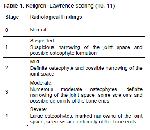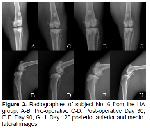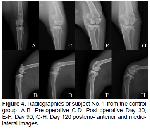This study was conducted with the approval number 46 dated 04.04.2013 by the Fırat University Rectorate Animal Experiments Ethics Board Presidency. The experimental animals were obtained from the Firat University Experimental Research Center (FUERC). The study was conducted at the FUERC and Firat University Animal Hospital Small Animal Clinic operation rooms.
Five-months old male and female 21 New Zealand rabbits with an average weight of 2700-3000 g were used in the study. The method of excising their anterior cruciate ligaments was employed in order to create experimental OA in the rabbits.
The rabbits were anaesthetized with a 5 mg/kg xylazine hydrochloride (Rompun®; 23.32mg/mL, Bayer, Istanbul, Turkey) and 35 mg/kg ketamine hydrochloride (Ketalar®; 50 mg/mL, Eczacibasi, Istanbul, Turkey) intramuscularly.
After anesthesia, the right knees of the rabbits were shaved and they were laid down in the supine position. Before the incision, the knees were sterilized with 10% Povidone iodine. Then, approaching with a latero-anterior longitudinal incision, the patella was deviated to the medial following lateral parapatellar arthrotomy and the anterior cruciate ligament was cut. After the anterior drawer test which was used to evaluate whether the cruciate ligament had been completely cut, the patellar tendon and skin of the rabbits were closed with separate stitches using polyglactin 2/0 suture material (Figure 1).

Büyütmek İçin Tıklayın |
Figure 1: Images of the operation site related to the cutting of the anterior cruciate ligament |
The experimental animals were allowed normal cage activity after the operation. 4 weeks after the surgical intervention, the rabbits were randomly divided into 3 equal groups. The first group of rabbits (n=7) were given 0.5 mL intra-articular bovine amniotic fluid (BAF) injections 3 times with one week in between. The second group of rabbits (n=7) were given 0.5 mL intra-articular hyaluronic acid (HA) applications 3 times with one week in between. The third group of rabbits (n=7) were used as a control group and nothing was applied to them (CONT).
The bovine amniotic fluid was taken post-mortem from an approximately 5-6 months pregnant, healthy cows amniotic sac under aseptic conditions from slaughterhouse with using sterile plastic injectors. It was brought to the laboratory without breaking the cold chain and kept at 20°C. It was allowed to dissolve by waiting for 15 minutes at room temperature before use. Sodium hyaluronate in a ready to use glass injector was used as hyaluronic acid (Ostenil®; 10 mg/mL, Bio-Gen, Ankara, Turkey).
Radiographs of the right genu joint of all subjects were taken in the posterio-anterior and medio-lateral position prior to operation and on the 30th, 90th and 120th days following the operation using the digital X-ray device found at the Fırat University Animal Hospital. The radiographs were evaluated using the Kellgren-Lawrence scoring system (Table 1). Sclerotic bone changes surrounding the joint edge, osteophytic growths extending outward from the joint edge, narrowing of the joint space and destructive changes in the bone ends were examined in this evaluation.
The statistical analysis of the results was done using the software "Statistical package for Social Sciences 22" (SPSS 22). After assessing whether there was a difference between the groups using the Kruskal-Wallis analysis method. Radiography scores were evaluated between the groups as a percentage using the Mann-Whitney U test in order to determine from which group the difference stemmed and whether it was a significant difference or not.









